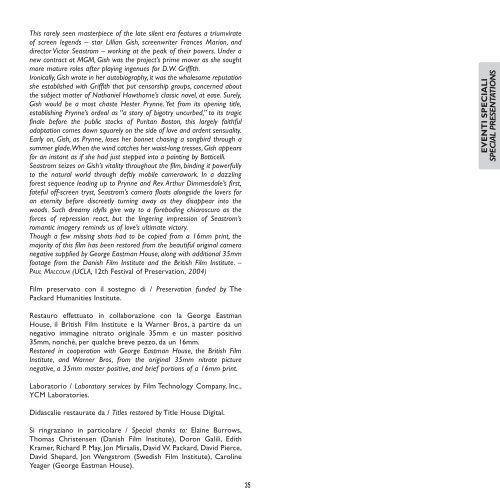Le Giornate del Cinema Muto 2005 Sommario / Contents
Le Giornate del Cinema Muto 2005 Sommario / Contents
Le Giornate del Cinema Muto 2005 Sommario / Contents
Create successful ePaper yourself
Turn your PDF publications into a flip-book with our unique Google optimized e-Paper software.
This rarely seen masterpiece of the late silent era features a triumvirate<br />
of screen legends – star Lillian Gish, screenwriter Frances Marion, and<br />
director Victor Seastrom – working at the peak of their powers. Under a<br />
new contract at MGM, Gish was the project’s prime mover as she sought<br />
more mature roles after playing ingenues for D.W. Griffith.<br />
Ironically, Gish wrote in her autobiography, it was the wholesome reputation<br />
she established with Griffith that put censorship groups, concerned about<br />
the subject matter of Nathaniel Hawthorne’s classic novel, at ease. Surely,<br />
Gish would be a most chaste Hester Prynne. Yet from its opening title,<br />
establishing Prynne’s ordeal as “a story of bigotry uncurbed,” to its tragic<br />
finale before the public stocks of Puritan Boston, this largely faithful<br />
adaptation comes down squarely on the side of love and ardent sensuality.<br />
Early on, Gish, as Prynne, loses her bonnet chasing a songbird through a<br />
summer glade.When the wind catches her waist-long tresses, Gish appears<br />
for an instant as if she had just stepped into a painting by Botticelli.<br />
Seastrom seizes on Gish’s vitality throughout the film, binding it powerfully<br />
to the natural world through deftly mobile camerawork. In a dazzling<br />
forest sequence leading up to Prynne and Rev. Arthur Dimmesdale’s first,<br />
fateful off-screen tryst, Seastrom’s camera floats alongside the lovers for<br />
an eternity before discreetly turning away as they disappear into the<br />
woods. Such dreamy idylls give way to a foreboding chiaroscuro as the<br />
forces of repression react, but the lingering impression of Seastrom’s<br />
romantic imagery reminds us of love’s ultimate victory.<br />
Though a few missing shots had to be copied from a 16mm print, the<br />
majority of this film has been restored from the beautiful original camera<br />
negative supplied by George Eastman House, along with additional 35mm<br />
footage from the Danish Film Institute and the British Film Institute. –<br />
PAUL MALCOLM (UCLA, 12th Festival of Preservation, 2004)<br />
Film preservato con il sostegno di / Preservation funded by The<br />
Packard Humanities Institute.<br />
Restauro effettuato in collaborazione con la George Eastman<br />
House, il British Film Institute e la Warner Bros, a partire da un<br />
negativo immagine nitrato originale 35mm e un master positivo<br />
35mm, nonché, per qualche breve pezzo, da un 16mm.<br />
Restored in cooperation with George Eastman House, the British Film<br />
Institute, and Warner Bros, from the original 35mm nitrate picture<br />
negative, a 35mm master positive, and brief portions of a 16mm print.<br />
Laboratorio / Laboratory services by Film Technology Company, Inc.,<br />
YCM Laboratories.<br />
Didascalie restaurate da / Titles restored by Title House Digital.<br />
Si ringraziano in particolare / Special thanks to: Elaine Burrows,<br />
Thomas Christensen (Danish Film Institute), Doron Galili, Edith<br />
Kramer, Richard P. May, Jon Mirsalis, David W. Packard, David Pierce,<br />
David Shepard, Jon Wengstrom (Swedish Film Institute), Caroline<br />
Yeager (George Eastman House).<br />
35<br />
EVENTI SPECIALI<br />
SPECIAL PRESENTATIONS
















